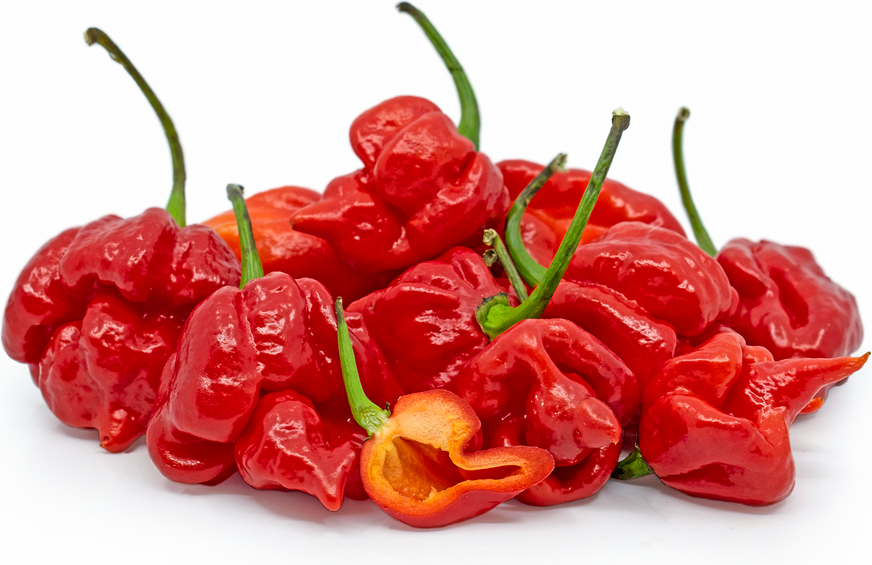


Red Scorpion Chile Peppers
Estimated Inventory, 8 ct : 0
This item was last sold on : 05/29/25
Description/Taste
Red Scorpion chile peppers are small, bulbous pods, averaging 5 to 7 centimeters in length and 1 to 5 centimeters in diameter, and have a gnarled shape tapering to a distinct and slightly curved, pointed tip. The skin is smooth, glossy, and lightly wrinkled with deep folds and creases, ripening from green, golden yellow, to red when mature. Underneath the surface, the flesh is pale red and crisp, encasing a central cavity filled with a few round and flat, cream-colored seeds. Red Scorpion chile peppers have a floral, fruity taste with an intense, pungent heat that builds in intensity and may become unpalatable to some.
Seasons/Availability
Red Scorpion chile peppers are available in the late spring through early fall.
Current Facts
Red Scorpion chile peppers, botanically classified as Capsicum chinense, are very hot pods that are members of the Solanaceae or nightshade family. Classified as a superhot variety, Red Scorpion chile peppers average 1,400,000-2,000,000 SHU on the Scoville scale and are considered to be one of the hottest peppers in the world. Red Scorpion chile peppers earn their name from their pointed, scorpion-like tail and are mature pods that have been left on the plant to fully ripen and develop the highest level of capsaicin, which is the chemical that triggers the brain to feel heat. Grown in hot weather climates, the pepper plants will widely vary in heat levels depending on the individual pepper, and there are also multiple variants of the original pepper generally classified under the Scorpion name, including the Trinidad Scorpion, Trinidad Moruga Scorpion, and the Trinidad Scorpion Butch T. Red Scorpion chile peppers are generally considered too hot to consume raw and are sparingly added to hot sauces, salsas, and marinades.
Nutritional Value
Red Scorpion chile peppers are an excellent source of vitamin C, which is an antioxidant that can help protect the immune system. The peppers also contain a very high amount of the chemical compound known as capsaicin, which triggers pain receptors in our body to feel the sensation of burning. Capsaicin has been shown to have anti-inflammatory properties and causes the body to release endorphins to counteract the perceived pain.
Applications
Red Scorpion chile peppers are rarely used raw, as their intense spice is often considered unpalatable, and caution should be taken before consuming the pods as the peppers can cause visceral reactions within the body. The peppers are most commonly added to hot sauces or salsas to add light flavoring and intense heat. When blended into hot sauces, bar-be-que sauces, and marinades, the spicy sauce can be used to flavor chicken wings, cooked meats, pasta, Asian noodle dishes, chilis, stews, and soups. Red Scorpion chile peppers can also be dried, ground into a powder, and used as a spice, or dehydrated and reconstituted for extended use. Red Scorpion chile powder can be used sparingly in dry rubs, rice and beans, and any application where hot sauce would be applied. When handling the peppers, it is important to wear gloves and goggles to protect the skin and eyes from the potent capsaicin. It is also recommended to work with the peppers in a well-ventilated space to avoid irritating the throat and lungs. Red Scorpion chile peppers will keep 1-2 weeks when loosely wrapped in plastic and stored whole and unwashed in the refrigerator.
Ethnic/Cultural Info
At New Mexico State University, the Chili Pepper Institute tested the Trinidad Scorpion chile pepper in 2012 to study the capsaicin levels within the pods and gain an accurate Scoville rating. Along with the Trinidad Scorpion, superhot peppers such as the 7-pot and bhut jolokia were also tested, and each variety had 125 plants cultivated for the study. When the pods were mature, they were harvested, dried, and ground into a powder. During this process, the capsaicin levels were found to be so high that the scientists had to keep changing into new sets of gloves as the capsaicin was making holes through the gloves.
Geography/History
Red Scorpion chile peppers are believed to be native to the central southern coast of Trinidad, a small island nation off the coast of Venezuela in South America, where the early versions of this pepper were developed by a local farmer named Wahid Ogeer. Today Red Scorpion chile peppers are widely studied at the University of the West Indies and the Chili Pepper Institute in New Mexico. The peppers are not sold in commercial markets and are considered to be a specialty variety grown for home gardening. Seeds are available through specific online catalogs in the United States, the Caribbean, Central America, and South America, and Australia, and there are many hot sauce varieties sold online that use the pepper as one of the ingredients.
Recipe Ideas
Recipes that include Red Scorpion Chile Peppers. One
| The Hot Pepper |
|
Black Scorpion Pepper Jelly |
| Caribbean Pot |
|
Blueberry Trinidad Moruga Scorpion Peppersauce |
| Chili Pepper Madness |
|
The Hottest Damn Hot Sauce I've Ever Made! |




